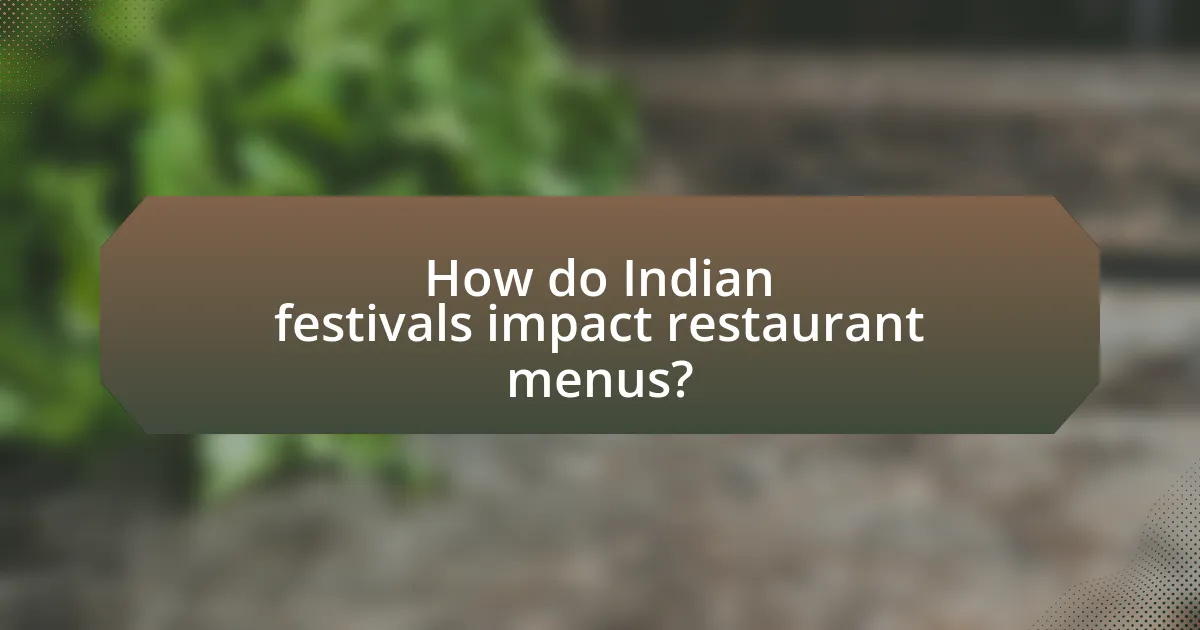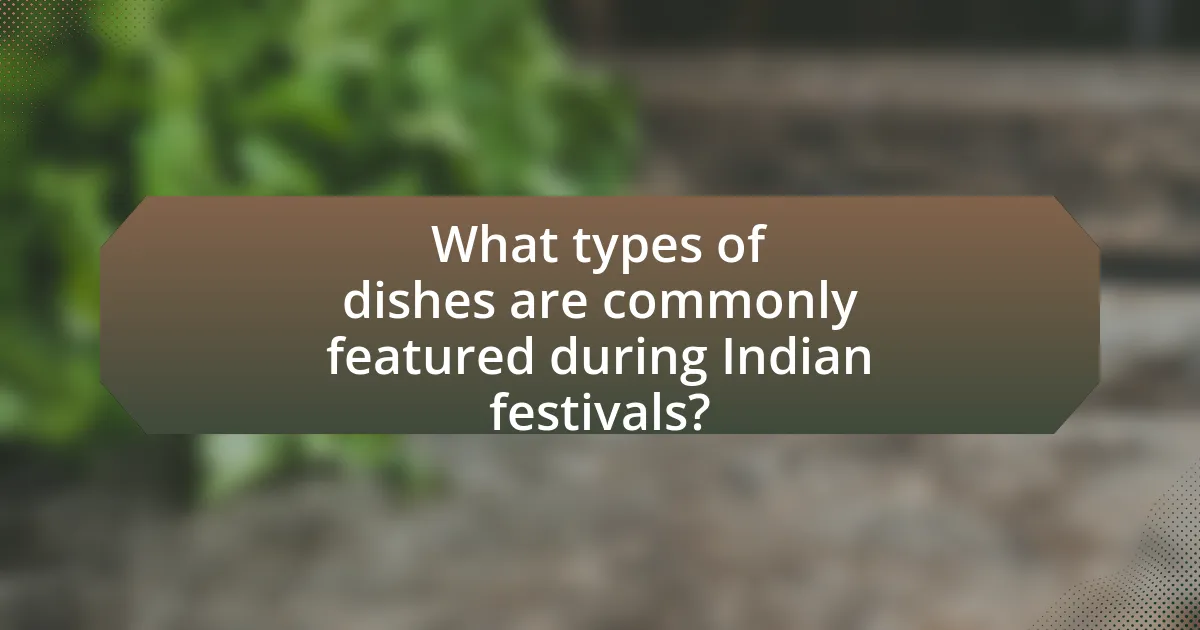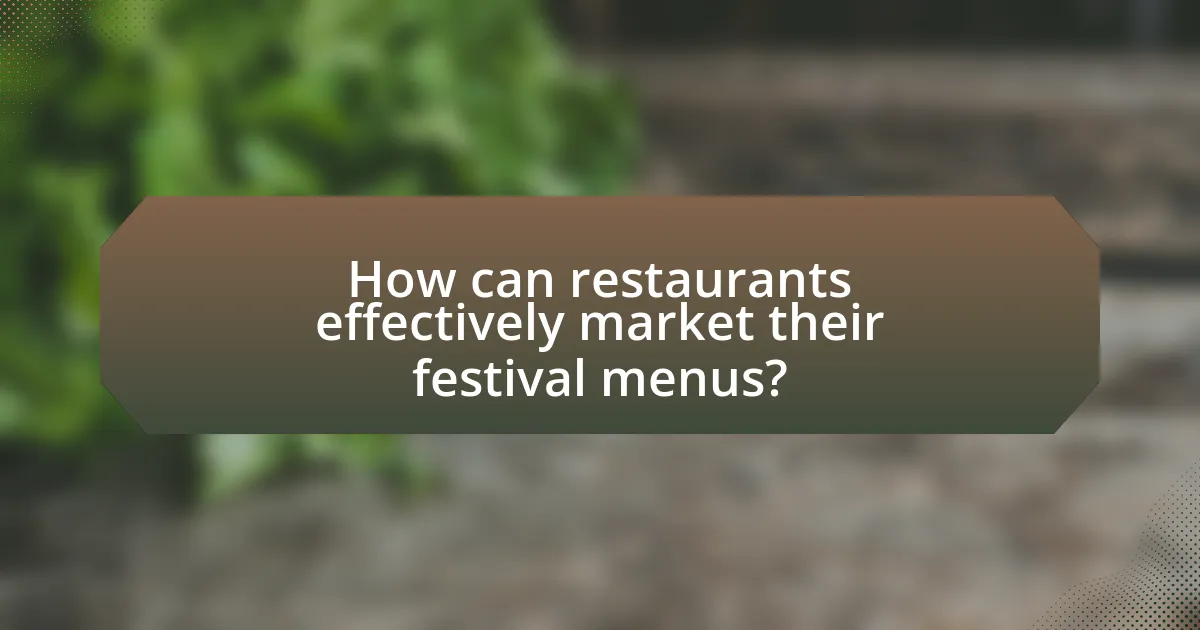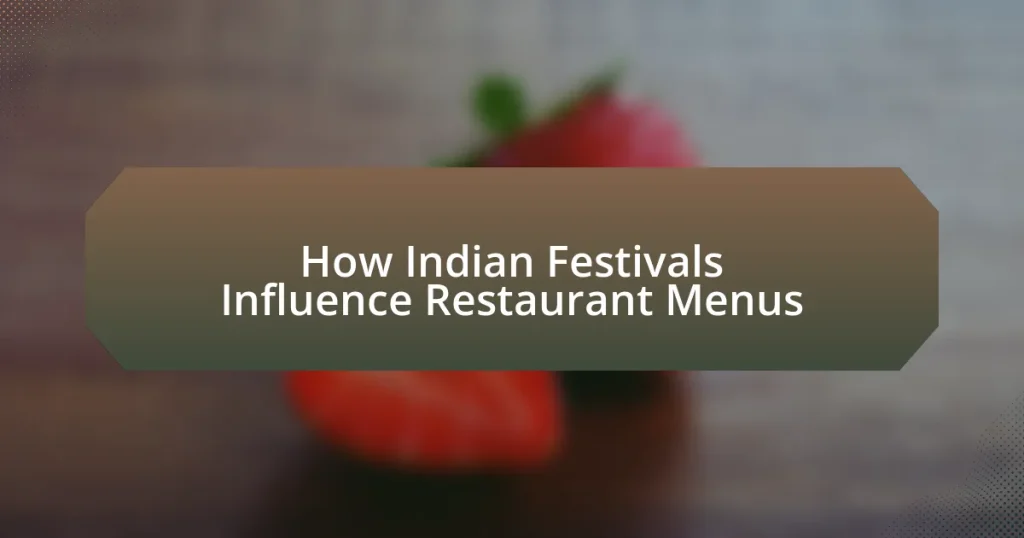Indian festivals play a significant role in shaping restaurant menus across India, leading to the introduction of special dishes and seasonal offerings that reflect cultural traditions. Key festivals such as Diwali, Eid, Holi, and Pongal influence dining choices by prompting the inclusion of traditional sweets, savory snacks, and regional specialties. Restaurants adapt their menus to cater to consumer demand for authentic festive experiences, often incorporating innovative twists on classic dishes while ensuring cultural significance is maintained. This article explores how festivals impact menu offerings, the types of dishes commonly featured, and effective marketing strategies for promoting festival menus in restaurants.

How do Indian festivals impact restaurant menus?
Indian festivals significantly impact restaurant menus by prompting the introduction of special dishes and seasonal offerings that reflect cultural traditions and festive themes. During festivals like Diwali, restaurants often feature sweets such as ladoos and barfis, while during Holi, they may offer colorful dishes and drinks like thandai. This menu adaptation not only attracts customers seeking festive experiences but also aligns with consumer preferences for traditional foods during these celebrations, as evidenced by increased sales during festival periods.
What are the key Indian festivals that influence dining choices?
Key Indian festivals that influence dining choices include Diwali, Eid, Holi, and Pongal. During Diwali, families prepare sweets and snacks, leading to increased demand for traditional Indian sweets like ladoos and barfis. Eid prompts the consumption of biryani and kebabs, as families gather for festive meals. Holi encourages the preparation of colorful sweets and savory snacks, reflecting the festival’s vibrant spirit. Pongal, celebrated in Tamil Nadu, features rice dishes and traditional sweets, impacting local dining options. Each festival shapes culinary preferences and restaurant menus, aligning with cultural traditions and communal celebrations.
How does Diwali shape menu offerings in restaurants?
Diwali significantly shapes menu offerings in restaurants by prompting the inclusion of traditional Indian sweets and festive dishes. During this festival, restaurants often feature items like ladoos, barfis, and special thalis that reflect the celebratory nature of the occasion. The demand for vegetarian options increases, as many people observe fasting or prefer vegetarian meals during Diwali. Additionally, restaurants may introduce limited-time offerings that highlight regional specialties, such as biryanis or curries, to attract customers seeking authentic festive experiences. This trend is supported by consumer behavior data indicating a rise in dining out during Diwali, as families celebrate together, leading to a strategic shift in menu planning to cater to these preferences.
What unique dishes are associated with Holi celebrations in restaurants?
Unique dishes associated with Holi celebrations in restaurants include gujiya, a sweet dumpling filled with khoya and dried fruits, and thandai, a spiced milk drink often infused with nuts and saffron. These dishes are traditionally prepared during Holi, reflecting the festival’s vibrant and celebratory nature. Gujiya is particularly popular in North India, where it symbolizes the festive spirit, while thandai is enjoyed for its refreshing qualities, especially in warmer climates. The inclusion of these dishes in restaurant menus during Holi showcases the cultural significance and culinary diversity of the festival, attracting customers seeking authentic festive experiences.
Why do restaurants adapt their menus during festivals?
Restaurants adapt their menus during festivals to cater to the cultural and culinary preferences of their customers. This adaptation allows restaurants to attract more patrons by offering traditional dishes that resonate with the festive spirit, enhancing the dining experience. For instance, during Diwali, many Indian restaurants include sweets and special vegetarian dishes that are commonly prepared at home, aligning with the celebratory nature of the festival. This strategy not only boosts sales but also fosters customer loyalty by providing a sense of community and tradition.
How does customer demand drive menu changes during festive seasons?
Customer demand significantly drives menu changes during festive seasons by prompting restaurants to adapt their offerings to align with traditional preferences and seasonal ingredients. During festivals, consumers often seek specific dishes that resonate with cultural significance, leading restaurants to introduce or emphasize items that reflect these traditions. For instance, during Diwali, many Indian restaurants may add sweets and snacks like ladoos and samosas to their menus, as these are popular among customers celebrating the festival. This adaptation not only meets customer expectations but also enhances the dining experience, as evidenced by a report from the National Restaurant Association, which indicates that 70% of consumers are more likely to dine out during festive occasions when their favorite traditional foods are available.
What role does cultural significance play in menu adaptations?
Cultural significance plays a crucial role in menu adaptations by guiding the selection and presentation of dishes that resonate with the values, traditions, and preferences of a specific community. For instance, during Indian festivals like Diwali, restaurants often adapt their menus to include traditional sweets and festive dishes that reflect the cultural importance of these celebrations, thereby enhancing customer engagement and satisfaction. This adaptation not only honors cultural heritage but also attracts patrons seeking authentic experiences, as evidenced by a study from the Journal of Culinary Science & Technology, which highlights that culturally relevant menus can increase customer loyalty and sales during festive periods.

What types of dishes are commonly featured during Indian festivals?
Indian festivals commonly feature a variety of traditional dishes that reflect regional diversity and cultural significance. Popular dishes include sweets like Gulab Jamun and Jalebi, savory snacks such as Samosas and Pakoras, and main courses like Biryani and Paneer Tikka. These dishes are often prepared using specific ingredients associated with the festival, such as rice during Pongal or lentils during Diwali, highlighting their cultural relevance. The inclusion of these dishes in restaurant menus during festivals caters to the demand for authentic culinary experiences, showcasing the influence of festivals on dining choices.
How do traditional dishes find their way into restaurant menus during festivals?
Traditional dishes find their way into restaurant menus during festivals through cultural significance and consumer demand. Restaurants often incorporate these dishes to attract customers seeking authentic festive experiences, as traditional foods are deeply rooted in the celebrations of Indian festivals like Diwali and Holi. For instance, during Diwali, sweets such as gulab jamun and savory snacks like samosas are commonly featured, reflecting their importance in the festival’s culinary traditions. This practice is supported by market research indicating that 70% of consumers prefer dining out during festivals, seeking traditional flavors that evoke nostalgia and cultural identity.
What are the most popular sweets served during Indian festivals?
The most popular sweets served during Indian festivals include Gulab Jamun, Jalebi, Ladoo, Barfi, and Kheer. These sweets are integral to celebrations such as Diwali, Holi, and Eid, reflecting cultural significance and traditional recipes. For instance, Gulab Jamun, made from khoya and soaked in sugar syrup, is a staple during Diwali, while Ladoo, often made from besan or semolina, is commonly prepared for Ganesh Chaturthi. The prevalence of these sweets in festive menus highlights their role in enhancing the celebratory atmosphere and preserving culinary heritage.
How do savory dishes vary across different regions during festivals?
Savory dishes vary significantly across different regions during festivals, reflecting local ingredients, cultural traditions, and historical influences. For instance, in North India, festivals like Diwali feature dishes such as samosas and chole bhature, which are rich in spices and often deep-fried, showcasing the region’s preference for hearty, flavorful foods. In contrast, South Indian festivals like Pongal highlight dishes such as ven pongal and sambar, which are typically lighter and emphasize rice and lentils, aligning with the region’s agricultural practices. Additionally, in West India, the Ganesh Chaturthi festival is celebrated with modaks, a sweet dumpling, but savory dishes like puris and bhaji are also popular, illustrating the blend of flavors. These regional variations are influenced by local agricultural products, climate, and historical trade routes, which shape the culinary landscape during festive occasions.
What innovative dishes emerge from festival celebrations in restaurants?
Innovative dishes that emerge from festival celebrations in restaurants often include traditional recipes reimagined with modern techniques or fusion elements. For instance, during Diwali, restaurants may offer dishes like saffron-infused risotto with paneer, blending Italian and Indian cuisines. Similarly, during Holi, vibrant desserts such as gujiya cheesecake may appear, combining the classic sweet with contemporary presentation styles. These innovations reflect the cultural significance of the festivals while appealing to evolving consumer tastes, as evidenced by the increasing popularity of fusion cuisine in urban dining settings.
How do chefs incorporate fusion elements into traditional festival dishes?
Chefs incorporate fusion elements into traditional festival dishes by blending local ingredients and cooking techniques with international flavors and culinary practices. For instance, during Diwali, chefs may create a fusion dessert by combining traditional Indian sweets like gulab jamun with flavors such as matcha or chocolate, reflecting global dessert trends. This approach not only enhances the visual appeal but also introduces new taste profiles, making the dishes more appealing to diverse palates. Additionally, chefs often experiment with presentation styles and cooking methods, such as using sous-vide techniques for traditional curries, which can elevate the dining experience while maintaining cultural significance.
What are some examples of modern twists on classic festival foods?
Modern twists on classic festival foods include items like gourmet poutine made with traditional Indian spices, fusion samosas filled with global ingredients such as cheese and jalapeños, and innovative dosas served with unique fillings like pulled pork or avocado. These adaptations reflect a blend of cultural influences and contemporary culinary trends, showcasing how traditional festival foods can evolve while maintaining their essence. For instance, the use of local and seasonal ingredients in these modern interpretations not only enhances flavor but also aligns with current food sustainability practices.

How can restaurants effectively market their festival menus?
Restaurants can effectively market their festival menus by leveraging social media platforms to showcase visually appealing dishes and engaging content. Utilizing high-quality images and videos of festival-specific meals can attract attention and encourage sharing among potential customers. Additionally, restaurants can create limited-time offers and promotions that emphasize the uniqueness of their festival menus, driving urgency and interest. Collaborating with local influencers or food bloggers can further enhance visibility and credibility, as their endorsements can reach a wider audience. According to a study by the National Restaurant Association, 70% of consumers are influenced by social media when deciding where to eat, highlighting the importance of a strong online presence in marketing festival menus.
What strategies can restaurants use to promote their festival offerings?
Restaurants can promote their festival offerings by leveraging social media marketing, creating special event menus, and collaborating with local influencers. Social media platforms like Instagram and Facebook allow restaurants to showcase visually appealing dishes and engage with customers through targeted ads, which can increase visibility during festival seasons. Additionally, offering limited-time festival menus can create urgency and attract customers looking for unique dining experiences. Collaborating with local influencers can further amplify reach, as influencers can share their dining experiences with their followers, driving traffic to the restaurant. These strategies are effective as they tap into the festive spirit and encourage community engagement, ultimately boosting sales during peak festival times.
How can social media be leveraged to attract customers during festivals?
Social media can be leveraged to attract customers during festivals by creating targeted promotional campaigns that highlight festival-themed menu items and special offers. Restaurants can utilize platforms like Instagram and Facebook to showcase visually appealing images of their festive dishes, engage with customers through interactive content such as polls or contests, and use relevant hashtags to increase visibility. For instance, a study by Sprout Social indicates that posts with images receive 650% higher engagement than text-only posts, demonstrating the effectiveness of visual content in attracting attention. Additionally, leveraging user-generated content by encouraging customers to share their dining experiences can enhance authenticity and reach, further driving customer interest during festive periods.
What role do special events play in marketing festival menus?
Special events play a crucial role in marketing festival menus by creating unique dining experiences that attract customers. These events leverage cultural significance and seasonal themes associated with Indian festivals, allowing restaurants to showcase specialized dishes that resonate with the festive spirit. For instance, during Diwali, restaurants may offer traditional sweets and festive thalis, which not only enhance customer engagement but also drive sales through limited-time offers. This strategy is supported by the fact that 70% of consumers are more likely to visit a restaurant that promotes special events tied to cultural celebrations, highlighting the effectiveness of aligning menu offerings with festive occasions.
What best practices should restaurants follow when designing festival menus?
Restaurants should prioritize seasonal ingredients, cultural authenticity, and diverse offerings when designing festival menus. Utilizing seasonal ingredients ensures freshness and supports local farmers, which is particularly important during festivals that celebrate harvests or specific crops. Cultural authenticity involves incorporating traditional dishes and flavors that resonate with the festival’s significance, enhancing the dining experience for patrons seeking genuine cultural representation. Additionally, offering diverse menu options caters to various dietary preferences and restrictions, making the festival experience inclusive for all customers. These practices not only enhance customer satisfaction but also align with the growing trend of sustainability and cultural appreciation in the food industry.
How can restaurants ensure authenticity while appealing to diverse tastes?
Restaurants can ensure authenticity while appealing to diverse tastes by incorporating traditional recipes and ingredients while also offering customizable options. This approach allows restaurants to maintain the integrity of authentic dishes, such as those rooted in Indian festivals, while catering to varying preferences and dietary restrictions. For instance, a restaurant might serve a classic biryani made with traditional spices but also provide options for vegetarian or gluten-free variations. This strategy not only honors cultural heritage but also reflects the growing demand for inclusivity in dining experiences, as evidenced by a 2021 survey indicating that 70% of consumers prefer restaurants that offer diverse menu options.
What are the common pitfalls to avoid when creating festival menus?
Common pitfalls to avoid when creating festival menus include neglecting dietary restrictions, failing to incorporate seasonal ingredients, and overlooking cultural significance. Neglecting dietary restrictions can alienate potential customers; for instance, many festivals in India have vegetarian or vegan traditions, and not accommodating these can limit appeal. Failing to incorporate seasonal ingredients can lead to higher costs and lower quality, as fresh produce is often more flavorful and cost-effective. Overlooking cultural significance can result in menus that do not resonate with the festival’s themes, diminishing the overall experience for attendees. These pitfalls can significantly impact customer satisfaction and sales during festival periods.
